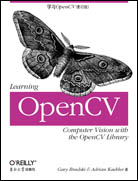
学习OpenCV(影印版)
出版时间:2009年04月
页数:555
《学习OpenCV》将你置身于迅速发展的计算机视觉领域。本书作者是免费开源OpenCV的发起人,这本书为你介绍了计算机视觉,例证了如何迅速建立使计算机能“看”的应用程序,以及如何基于计算机获取的数据作出决策。
计算机视觉几乎随处可见:安全系统、管理检验系统、医学图像分析、无人机等。它将Google地图和Google地球结合在一起,在LCD屏幕上核对像素,确保衬衫上的每一个针脚都完全缝合。
OpenCV提供了一个简易实用的计算机视觉框架以及一个含有超过500种可以实时运行视觉代码的函数的综合库。
《学习OpenCV》在每一章里教授任何OpenCV的开发者或热爱者如何在这些实战经验的帮助下迅速掌握该软件。这本书包括了如下内容:
* 对OpenCV全面详尽的介绍
* 从照相机中导入图片
* 转换图像
* 分割图像和形状匹配
* 模式识别,包括人脸检测
* 两到三个计量单位间的跟踪和运动
* 立体视觉中的3D再现
* 机器学习算法
使机器能看见是一个具有挑战却又充满乐趣的目标。无论你是想建立一个简单的还是复杂的视觉应用程序,《学习OpenCV》都是你入门的必备教材。
“这本宝库对专业人员来讲非常有用,对初涉这个领域的人们也是个绝好的工具。像其宣传的那样,它是一组计算机视觉算法。”
——William T. Freeman,麻省理工学院计算机科学与人工智能实验室
“《学习OpenCV》即将占据每个从事计算机视觉领域的人的书架上最显著的一处。”
——David Lowe,英属哥伦比亚大学计算机科学教授
Gary Rost Bradski博士,斯坦福大学人工智能实验室的顾问教授,也是Willow Garage公司机器人学研究协会的资深科学家。
Adrian Kaehler博士,Applied Minds公司的资深科学家,从事机器学习、统计建模、计算机视觉和机器人学方面的研究。
计算机视觉几乎随处可见:安全系统、管理检验系统、医学图像分析、无人机等。它将Google地图和Google地球结合在一起,在LCD屏幕上核对像素,确保衬衫上的每一个针脚都完全缝合。
OpenCV提供了一个简易实用的计算机视觉框架以及一个含有超过500种可以实时运行视觉代码的函数的综合库。
《学习OpenCV》在每一章里教授任何OpenCV的开发者或热爱者如何在这些实战经验的帮助下迅速掌握该软件。这本书包括了如下内容:
* 对OpenCV全面详尽的介绍
* 从照相机中导入图片
* 转换图像
* 分割图像和形状匹配
* 模式识别,包括人脸检测
* 两到三个计量单位间的跟踪和运动
* 立体视觉中的3D再现
* 机器学习算法
使机器能看见是一个具有挑战却又充满乐趣的目标。无论你是想建立一个简单的还是复杂的视觉应用程序,《学习OpenCV》都是你入门的必备教材。
“这本宝库对专业人员来讲非常有用,对初涉这个领域的人们也是个绝好的工具。像其宣传的那样,它是一组计算机视觉算法。”
——William T. Freeman,麻省理工学院计算机科学与人工智能实验室
“《学习OpenCV》即将占据每个从事计算机视觉领域的人的书架上最显著的一处。”
——David Lowe,英属哥伦比亚大学计算机科学教授
Gary Rost Bradski博士,斯坦福大学人工智能实验室的顾问教授,也是Willow Garage公司机器人学研究协会的资深科学家。
Adrian Kaehler博士,Applied Minds公司的资深科学家,从事机器学习、统计建模、计算机视觉和机器人学方面的研究。
- Preface
- 1. Overview
- What Is OpenCV?
- Who Uses OpenCV?
- What Is Computer Vision?
- The Origin of OpenCV
- Downloading and Installing OpenCV
- Getting the Latest OpenCV via CVS
- More OpenCV Documentation
- OpenCV Structure and Content
- Portability
- Exercises
- 2. Introduction to OpenCV
- Getting Started
- First Program—Display a Picture
- Second Program—AVI Video
- Moving Around
- A Simple Transformation
- A Not-So-Simple Transformation
- Input from a Camera
- Writing to an AVI File
- Onward
- Exercises
- 3. Getting to Know OpenCV
- OpenCV Primitive Data Types
- CvMat Matrix Structure
- IplImage Data Structure
- Matrix and Image Operators
- Drawing Things
- Data Persistence
- Integrated Performance Primitives
- Summary
- Exercises
- 4. HighGUI
- A Portable Graphics Toolkit
- Creating a Window
- Loading an Image
- Displaying Images
- Working with Video
- ConvertImage
- Exercises
- 5. Image Processing
- Overview
- Smoothing
- Image Morphology
- Flood Fill
- Resize
- Image Pyramids
- Threshold
- Exercises
- 6. Image Transforms
- Overview
- Convolution
- Gradients and Sobel Derivatives
- Laplace
- Canny
- Hough Transforms
- Remap
- Stretch, Shrink, Warp, and Rotate
- CartToPolar and PolarToCart
- LogPolar
- Discrete Fourier Transform (DFT)
- Discrete Cosine Transform (DCT)
- Integral Images
- Distance Transform
- Histogram Equalization
- Exercises
- 7. Histograms and Matching
- Basic Histogram Data Structure
- Accessing Histograms
- Basic Manipulations with Histograms
- Some More Complicated Stuff
- Exercises
- 8. Contours
- Memory Storage
- Sequences
- Contour Finding
- Another Contour Example
- More to Do with Contours
- Matching Contours
- Exercises
- 9. Image Parts and Segmentation
- Parts and Segments
- Background Subtraction
- Watershed Algorithm
- Image Repair by Inpainting
- Mean-Shift Segmentation
- Delaunay Triangulation, Voronoi Tesselation
- Exercises
- 10. Tracking and Motion
- The Basics of Tracking
- Corner Finding
- Subpixel Corners
- Invariant Features
- Optical Flow
- Mean-Shift and Camshift Tracking
- Motion Templates
- Estimators
- The Condensation Algorithm
- Exercises
- 11. Camera Models and Calibration
- Camera Model
- Calibration
- Undistortion
- Putting Calibration All Together
- Rodrigues Transform
- Exercises
- 12. Projection and 3D Vision
- Projections
- Affine and Perspective Transformations
- POSIT: 3D Pose Estimation
- Stereo Imaging
- Structure from Motion
- Fitting Lines in Two and Three Dimensions
- Exercises
- 13. Machine Learning
- What Is Machine Learning
- Common Routines in the ML Library
- Mahalanobis Distance
- K-Means
- Nai?Nve/Normal Bayes Classifier
- Binary Decision Trees
- Boosting
- Random Trees
- Face Detection or Haar Classifier
- Other Machine Learning Algorithms
- Exercises
- 14. OpenCV’s Future
- Past and Future
- Directions
- OpenCV for Artists
- Afterword
- Bibliography
- Index
书名:学习OpenCV(影印版)
作者:Gary Bradski, Adrian Kaehler 著
国内出版社:东南大学出版社
出版时间:2009年04月
页数:555
书号:978-7-5641-1629-3
原版书出版商:O'Reilly Media
Th e image on the cover of Learning OpenCV is a giant, or great, peacock moth (Saturnia
pyri). Native to Europe, the moth’s range includes southern France and Italy, the Iberian
Peninsula, and parts of Siberia and northern Africa. It inhabits open landscapes
with scattered trees and shrubs and can oft en be found in parklands, orchards, and
vineyards, where it rests under shade trees during the day.
Th e largest of the European moths, giant peacock moths have a wingspan of up to six
inches; their size and nocturnal nature can lead some observers to mistake them for
bats. Th eir wings are gray and grayish-brown with accents of white and yellow. In the
center of each wing, giant peacock moths have a large eyespot, a distinctive pattern most
commonly associated with the birds they are named for.
pyri). Native to Europe, the moth’s range includes southern France and Italy, the Iberian
Peninsula, and parts of Siberia and northern Africa. It inhabits open landscapes
with scattered trees and shrubs and can oft en be found in parklands, orchards, and
vineyards, where it rests under shade trees during the day.
Th e largest of the European moths, giant peacock moths have a wingspan of up to six
inches; their size and nocturnal nature can lead some observers to mistake them for
bats. Th eir wings are gray and grayish-brown with accents of white and yellow. In the
center of each wing, giant peacock moths have a large eyespot, a distinctive pattern most
commonly associated with the birds they are named for.
购买选项